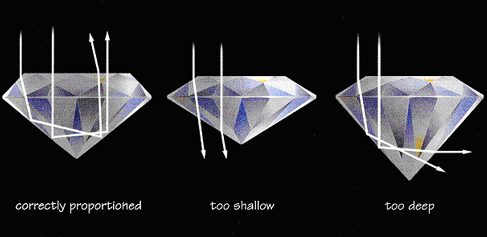Diamonds
Since our inventory changes so often, there are no loose diamonds listed. However we always have an extensive inventory of rounds, princess cuts, emerald cuts, ovals, marquise and pears on hand. We pick and choose very carefully selecting only those stones that meet our strict criteria spelled out below so that our customers are assured of a product that will produce beauty, brilliance and value. Contact us to be refered to one of many jewelers near you that carry or have our inventory at their disposal.
Important Aspects of a Diamond
The cut, color, clarity and carat weight of a diamond are known around the world as the four C’s. The combination of these four characteristics is what determines a stones beauty, desirability and value. When deciding what combination of the four C’s is most important, you must keep in mind one thing . Light and its interaction with a diamond is what allows a stones fire, brilliance and overall beauty to be revealed.
The largest factor that deals directly with light is the cut of a diamond. Cut is not just the outline or shape of a stone but its proportions. The basic idea of a well cut diamond is to collect light so that it will reflect and disperse it back through the top of the stone to the viewers eye in the form of brilliance, fire and scintillation.

A poorly cut diamond will allow most of the collected light to leak out the bottom or sides, resulting in a stone that may not look its size and has a dull and lifeless appearance. While cut may not be the most obvious of the characteristics to see in detail it is the one thing that can be most noticed and appreciated to the untrained eye.
The Color of a diamond is the next factor that determines a stones desirability. A basic “D” to “Z” scale is used to grade a diamond and give a representation of the stones depth of color and to determine how noticeable it is. A “D” color diamond is the highest on the scale, and displays no color were as a “Z” colored stone displays light yellow or brownish tone and saturation.
Color grades are generally referred to in groups such as D to F (colorless), (G to J) near colorless and the K grade and beyond is considered to be (faint, very light and light yellow). Generally stones in the near colorless or better range are more desirable for jewelry where the color actually enhances the brightness of the stone. On the other end of the scale past the Z grade or any color other than yellow or brown lies the fancy colors. These color diamonds can be almost any color and range from yellows to blues, red and pinks to name a few. Fancy color diamonds are rare and more expensive that stones in the normal color range.
The clarity of a diamond is the next factor that determines the value and beauty of a stone. The clarity characteristics of a diamond can range in a variety of different ways. It is important to remember that diamond is a mineral formed deep in the earth under extreme heat and pressure, and what nature has left internally are the result. They can range from trapped crystals to growth marks and breaks in the stone. Like color, the clarity of a stone is also graded on a scale and that grade affects the value and beauty of a diamond. This scale ranges from flawless to included.
A diamond may have been assigned a clarity grade by someone, but this often does not tell the complete story. A clarity grade is made up of separate factors. These include the size of the flaw or flaws, the number of them and color of the characteristics. Their location in the stone, how visible they are and if they pose any danger to the diamond are also considered when determining a final clarity grade. So selecting a diamond solely on the basis of what is printed on a piece of paper should never be a substitute for examining the diamond with your own eyes.
The final C is of course carat weight, which is probably the most visible factor to see in considering the value of a diamond. The Carat system is a weight not just a measurement, and like pennies to a dollar there are one hundred points in a carat. This is important again when looking at the cut of a diamond. A stone could weigh one carat but because it is poorly cut the stone may look much smaller or much larger than it should but neither will have the sparkle and brilliance of a well proportioned stone. Diamonds are valued based on demand and their rarity. Larger stones are much more rare than smaller ones, so the per carat price of a large stone is more than the per carat price of a small stone of the same quality.
Location
J.P. Knight Diamonds LLC
Cincinnati, Ohio 45255
